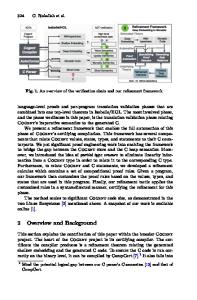Automatic Generation of Functional Mock-Up Units from Formal Specifications
This paper reports on the approach used to augment a transition system tool with automatic Functional Mock-up Units (FMU) generation. To verify the FMU properties, the same transition system can be translated into a formal language. Among intrinsic system
- PDF / 10,246,911 Bytes
- 284 Pages / 439.37 x 666.142 pts Page_size
- 35 Downloads / 352 Views
Javier Camara Martin Steffen (Eds.)
Software Engineering and Formal Methods SEFM 2019 Collocated Workshops: CoSim-CPS, ASYDE, CIFMA, and FOCLASA Oslo, Norway, September 16–20, 2019, Revised Selected Papers
Lecture Notes in Computer Science Founding Editors Gerhard Goos Karlsruhe Institute of Technology, Karlsruhe, Germany Juris Hartmanis Cornell University, Ithaca, NY, USA
Editorial Board Members Elisa Bertino Purdue University, West Lafayette, IN, USA Wen Gao Peking University, Beijing, China Bernhard Steffen TU Dortmund University, Dortmund, Germany Gerhard Woeginger RWTH Aachen, Aachen, Germany Moti Yung Columbia University, New York, NY, USA
12226
More information about this series at http://www.springer.com/series/7408
Javier Camara Martin Steffen (Eds.) •
Software Engineering and Formal Methods SEFM 2019 Collocated Workshops: CoSim-CPS, ASYDE, CIFMA, and FOCLASA Oslo, Norway, September 16–20, 2019 Revised Selected Papers
123
Editors Javier Camara Department of Computer Science University of York York, UK
Martin Steffen Department of Informatics University of Oslo Oslo, Norway
ISSN 0302-9743 ISSN 1611-3349 (electronic) Lecture Notes in Computer Science ISBN 978-3-030-57505-2 ISBN 978-3-030-57506-9 (eBook) https://doi.org/10.1007/978-3-030-57506-9 LNCS Sublibrary: SL2 – Programming and Software Engineering © Springer Nature Switzerland AG 2020 Chapter “Behaviour and Reasoning Description Language (BRDL)” is licensed under the terms of the Creative Commons Attribution 4.0 International License (http://creativecommons.org/licenses/by/4.0/). For further details see license information in the chapter. This work is subject to copyright. All rights are reserved by the Publisher, whether the whole or part of the material is concerned, specifically the rights of translation, reprinting, reuse of illustrations, recitation, broadcasting, reproduction on microfilms or in any other physical way, and transmission or information storage and retrieval, electronic adaptation, computer software, or by similar or dissimilar methodology now known or hereafter developed. The use of general descriptive names, registered names, trademarks, service marks, etc. in this publication does not imply, even in the absence of a specific statement, that such names are exempt from the relevant protective laws and regulations and therefore free for general use. The publisher, the authors and the editors are safe to assume that the advice and information in this book are believed to be true and accurate at the date of publication. Neither the publisher nor the authors or the editors give a warranty, expressed or implied, with respect to the material contained herein or for any errors or omissions that may have been made. The publisher remains neutral with regard to jurisdictional claims in published maps and institutional affiliations. This Springer imprint is published by the registered company Springer Nature Switzerland AG The registered company address is: Gewerbestrasse 11, 6330 Cham, Switzerland
Preface
This volume contains t
Data Loading...










